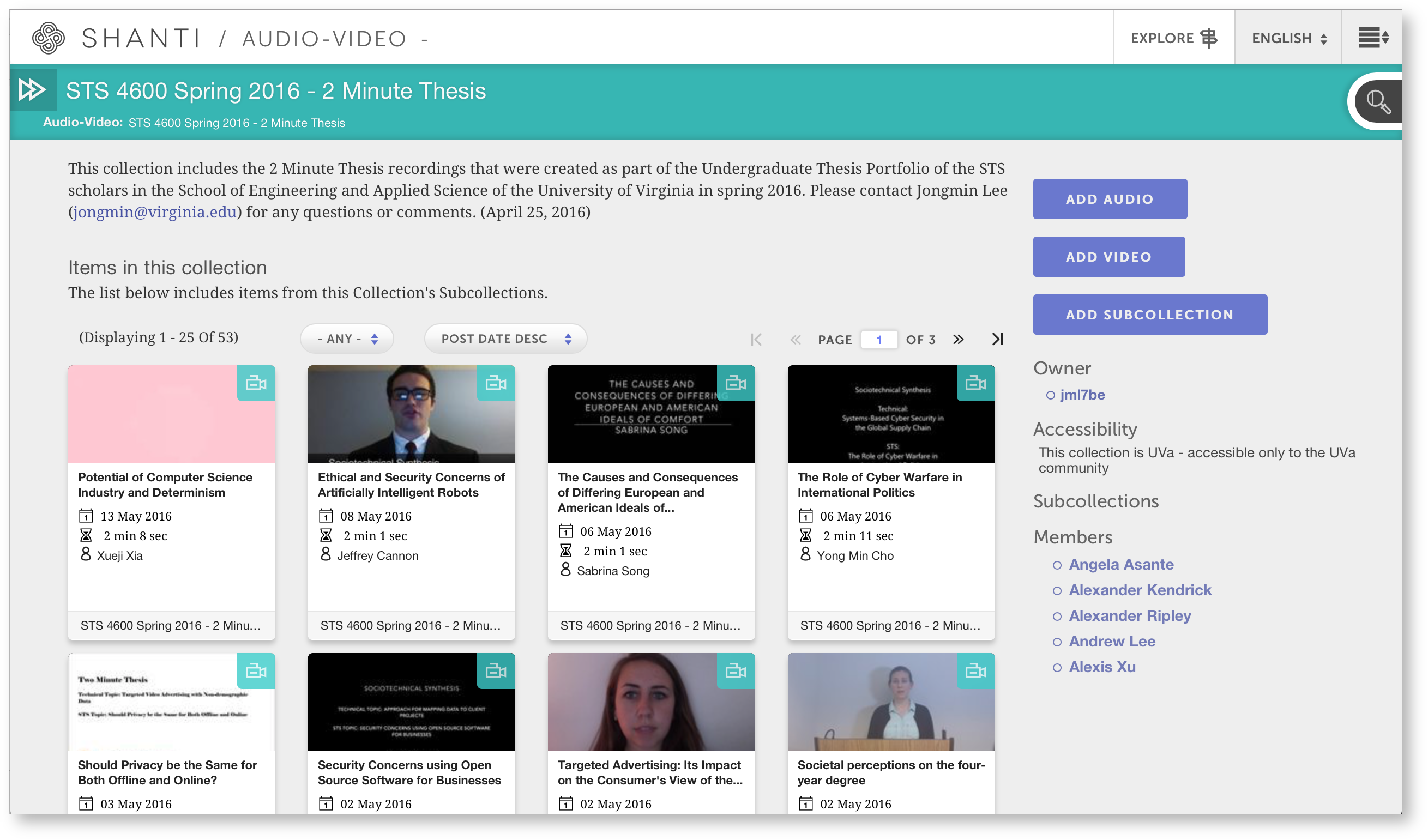Mandala’s audio-video collections (audio-video.shanti.virginia.edu) have many uses in the classroom. Here, we’ll go over the most common: research and collection projects.
If you want to use Mandala Audio-Video for your class, start thinking about your project and assignments early. Than Grove (than@virginia.edu) is available if you need help.
If you're an instructor, we suggest you devote some class time to completing projects and teaching students how to use Audio-Video. This lets you solve problems quickly and efficiently for the whole class.
Student Research
Collection Projects
FAQs
Acknowledgements
Using Audio-Video
Media in Mandala Audio-Video is organized in collections and subcollections, which are groupings of sounds and video resources. Each collection is associated with a group of members, which have specific adding or viewing permissions. You can think of collections as "folders" that house your files, with member restrictions.
You need to have a collection to add resources. Only members of a collection can upload videos to the collections. Public collections can be viewed by anyone, while private collections can only be viewed by group members.
Example
A professor might have a master collection called "STS and Engineering Practice," which they made using the Create a Collection guide. The "STS and Engineering Practice" folder might contain a subcollection for each semester, like "STS 4500 Fall 2017," "STS 4500 Fall 2016," etc. The professor then makes his students members of the subcollections using the Add New Collection Members guide and their student's computing ids.
Student Research
Students can use media on Mandala as sources for their own research. They can do this without an account, but an account will unlock extra features.
Collection Projects
Students can create their own collections of audio and video. Instructors can create these collections for the entire class, or students can create their own collections for themselves and their teams.
Students need to login to Mandala with their NetBadge account before you can add them to collections. Logging in creates their Mandala account automatically.
To make a collection where everyone in the class is a contributor:
- Students log in with NetBadge
- See Log In to Mandala for help
- Students only need to log in once to create their account
- The instructor creates the collection
- Use the Create a Collection guide
- You'll need your students' computing ids
- The instructor adds students as members
- Use the Add New Collection Members guide
- Students add their videos as needed
- Remember: titles and descriptions can always be edited later
- Pay close attention to metadata, including privacy settings and copyrights
If students need their own collections, they should:
- Log in to audio-video.shanti.virginia.edu with Netbadge
- Create a collection
- Add teammates or the instructor as members of the collection
- New members must have already created accounts by logging in
- Upload their video and audio files
A note on privacy:
You can restrict access to both collections as a whole and individual videos. You can restrict access to collection members only, UVA members only, or the general public. You can also place embargos on access.
FAQs
I don’t want to micromanage my students: where can they go for help?
This UVA Knowledge Base contains clear and succinct step-by-step guides to completing tasks in Mandala Audio-Video. (And if you want to find out something that isn’t in the guide, let us know. We’re always adding new content to meet UVA needs.)
I get a "You have entered an invalid user name" error when I try to add a student to a collection. What happened?
Your student needs to log in to Audio-Video at least once before you can add them as a member. Logging in with NetBadge for the first time creates their account automatically.
Do I need to add my students to a class collection one-by-one?
Unfortunately, yes. There's currently no way to add members in bulk. The Audio-Video team is currently working on this feature, however, so stay tuned.
What if we find a bug in the application?
Contact Than Grove — he’ll sort it out as soon as possible!
How do I get a direct link to a specific video?
Open the collection that contains the video, then click on the video's thumbnail. The resource will open.
You can now copy the URL in your browser – it should look something like https://audio-video.shanti.virginia.edu/video/___. This URL takes viewers directly to the video. Remember, if your video is private, viewers need to be members of the collection or subcollection, and they need to be signed in to Audio-Video.
All this is theoretical. What have other instructors done with Mandala?
Check out the 2 Minute Thesis collection by Dr. Jongmin Lee and STS scholars in the School of Engineering and Applied Science at UVA. Undergraduate students uploaded video summaries of their theses to a group collection. Each student could decide whether the video stayed private to UVA or was displayed to the public, though the collection itself is restricted to UVA members. Using the video’s unique URL and a free QR generator, students then embedded QR codes of the video in their final thesis projects.
Acknowledgements
Special thanks to Dr. Lee, Than Grove, and Rebecca Rosenblatt for developing the workflow that inspired this guide.
